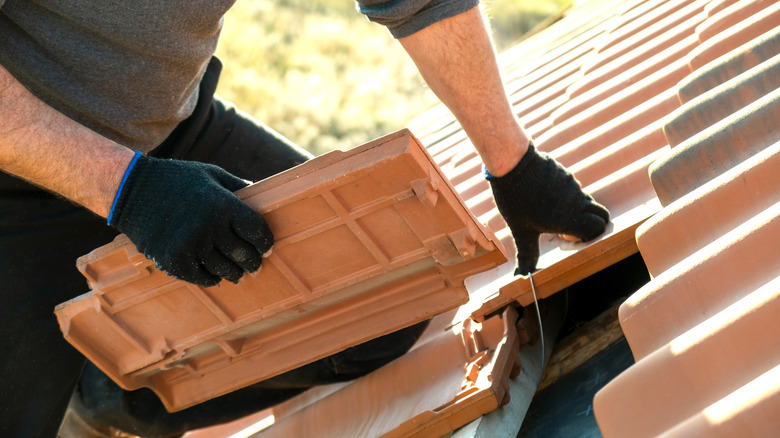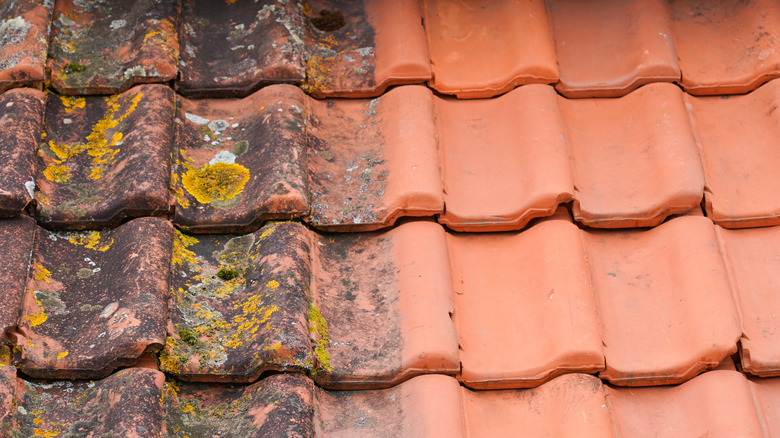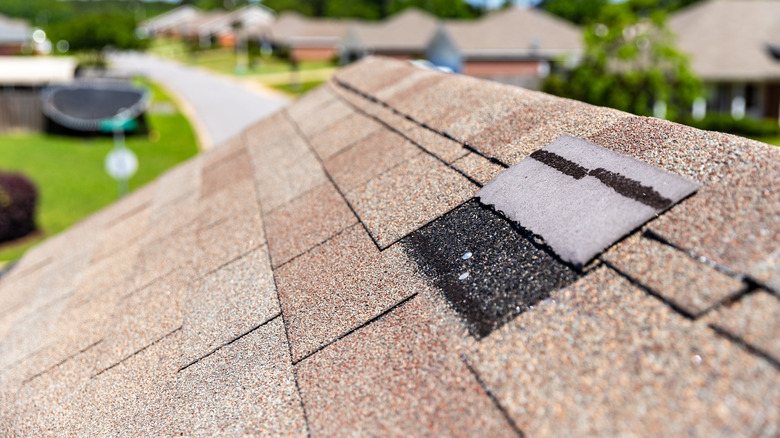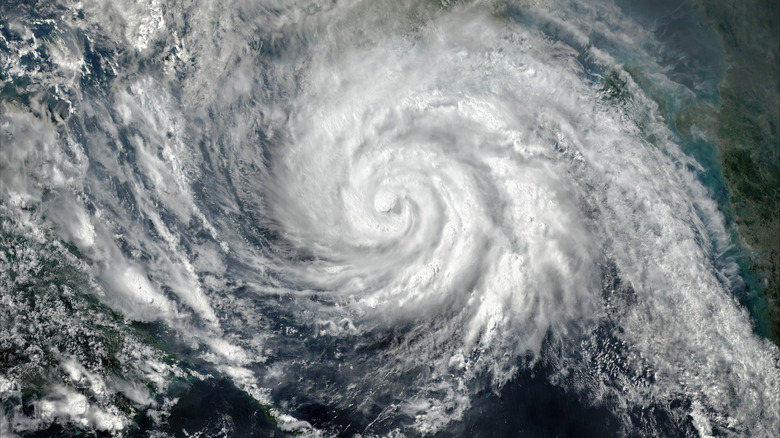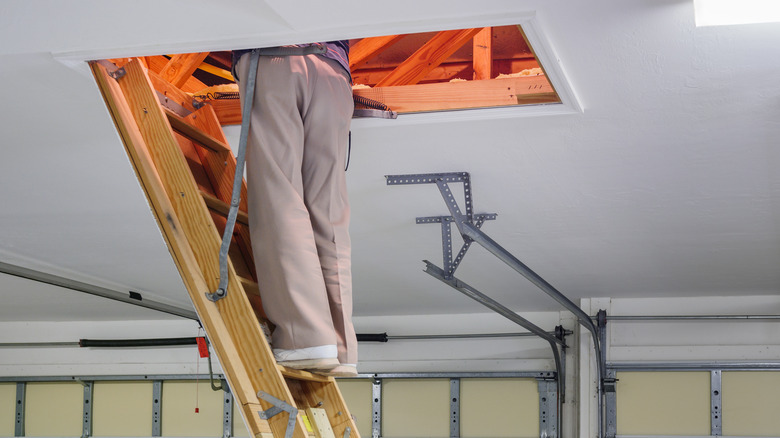How Often You Should Really Be Replacing Your Roof
Roof replacements are an inevitable part of homeownership. Houses are protected from the worst of the elements outside their four walls by a series of constructed pieces, and the roof is perhaps the feature that takes the greatest beating on a daily, monthly, and yearly basis. O'Lyn Roofing notes that in the summer, the temperature on top of your roof can register up to 20 degrees Fahrenheit hotter than the measure taken at ground level. This poses a potential risk for roofers working through the intense summer heat, but it also illuminates a feature of the roof itself.
Because of the intensity of the elements — the massive heat difference, direct rain exposure, and other environmental factors — the roof withstands quite the onslaught. It will typically need replacing after about 20 years, with varying ranges based on construction materials and a bit of luck added in, according to Roof Advisor. The first factor in determining roof replacement schedules is time. After a certain length, the roofing material will lose its effectiveness and may even start lifting away from the surface. But the age of a roof isn't the only factor to consider when asking yourself or a roofer about your next roof replacement timeline. There are some other considerations to make that can help you determine the right decision for your home and family within it.
Age is situated centrally in this decision
The roof's age plays an outsized role when you need to replace the feature, and the 20-year mark is a good standard to go by if your area doesn't see harsh weather conditions regularly. Roof Advisor notes that most asphalt roofing systems will last 15 to 30 years, but this can vary depending on your ongoing care routine, the weather your roof must withstand, and much more. Certain roofing materials will last far longer, with metal roofs potentially prevailing as long as 75 years if well cared for. On the other hand, composition shingle roofs may need a replacement after as little as 12 years.
These Roof Advisor estimates can help you gauge the remaining lifespan of your roof, but they only act as a guide. It's important to continually evaluate the condition and wear patterns on your home's upper surface. Roof Revivers notes that homeowners should inspect their roofs at least twice yearly to assess any changes. Damage in this part of the home can happen quickly, and once it does, it can severely impact the security and comfort you enjoy within the property. Keeping age in mind and inspecting the roof's surface and underside (from the attic) regularly will help you understand the remaining time your roof has, ensuring that a replacement requirement won't sneak up on you.
Signs of damage signal a looming replacement
While time is an excellent indicator of the continued functionality of a roof, this isn't the only metric to go by. Indeed, a roof can require replacing much sooner than the typical 20-year milestone. Waiting to prepare for a replacement until you are arriving at this length of time is a surefire way to get caught flat-footed by the needs of your home and their financial ramifications. Signs of damage can indicate that your roof is failing before it reaches the typical life expectancy marker. Splitting roofing segments, cracks, rot, and puncture wounds on the surface can all indicate a failure (or imminent failure) of your roof, according to Abbey Roofing.
Fortunately for homeowners, damages that come into play on a roof often take many months or years to develop into significant problems that need immediate attention. Unless you've been exposed to hurricane-force winds or powerful blizzards that have deposited many feet of dense, heavy snow on top of the roof, the damage is overwhelmingly slow moving on this part of the home. As a result, the importance of checking your roof for increased wear or new damage on a routine basis (every six months or so) cannot be overstated.
Extreme weather events or damage move up the timeline
Extreme weather is another cause of roofing replacement needs. Unlike time and routine wear, severe winds, extended exposure to water, or the immense weight of snowfall can push a roof past its breaking point. Roof Revivers report that lousy weather of all sorts can increase the wear rate on the roofing system, and extreme weather systems that occur all across the country can significantly impact the roof in several ways.
For instance, hurricanes strike the east coast of the United States every summer and fall, with storms making their way inland across the Atlantic coast into the Gulf and making landfall in Texas or Louisiana. A good deal of the southeastern quarter of the contiguous U.S. landmass must contend with the gales of hurricane season. Farther west, middle country states experience frequent tornadoes, freezing temperatures, and immense snowfall. Along the Pacific coast, forest fires rage throughout the years, leading to the total loss or damage to countless properties. Bankrate reports that 4.5 million U.S. homes are at high or extreme risk of damage or loss from these fires. Severe weather can immediately impact your roof's structural integrity, leading to replacing a roof as a matter of urgency rather than a general convenience.
High heat can lead to shortened effective length
Intense heat can thwart the effectiveness of a roof as well. High Point Roofing reports that heatwaves and extended periods of intense heat exposure can degrade the integrity of roofing structures at a faster pace than is typical during periods of routine weather. Considering that the roof sees a higher overall temperature than the ground (via O'Lyn Roofing), even slightly elevated temperatures can lead to a faster countdown on your roof's viability clock. This is a critical consideration as the average global temperatures experienced continue to tick each year upward. Chiefly, the longer your roof has been in place, the more time it's been exposed to these inflated temperatures.
While a single degree off the norm might not register to the average commuter or homeowner, this change, coupled with the intensity of heat on top of your home and the daily exposure, can lead to generally shorter lifespans for roofing materials. Once again, the best means of understanding the effects of temperature changes on your roof is to continually inspect the structure for damage, wear, and signs of failure.
Leaks or visible light flowing into the attic
A sure sign that you're dealing with a structural issue in the roof is the visibility of light from outside pouring into the attic beneath, according to Resilient Roofing. This is why a roof inspection isn't complete until you've checked out the attic. Inside the attic, you can easily spot these flows of light that might make their way through the exterior surface. Likewise, you can't find a leak coming into the house from outside. The attic can provide a great vantage point to inspect some of the consequences of a failing roof.
Resilient Roofing suggests calling a professional for a second opinion when you find a leak or visible light passing into the attic from the roof. A roofer will be able to quickly deduce whether you're dealing with a significant roofing system failure or the first signs that your roof is beginning to wear out. Depending on the prognosis, you might need an immediate replacement or one in the coming months. A professional is your best bet when finding either of these issues on the roof.
